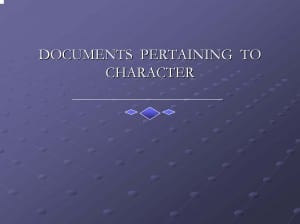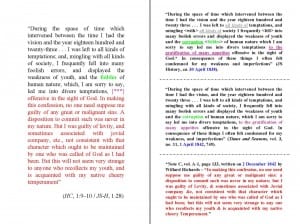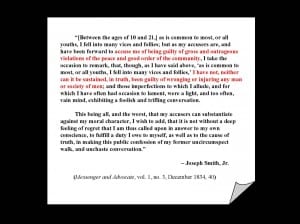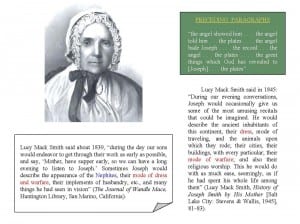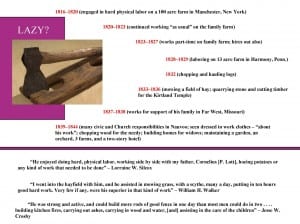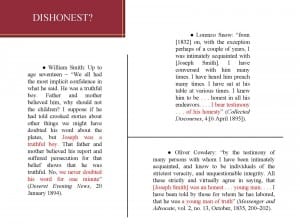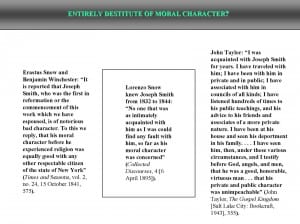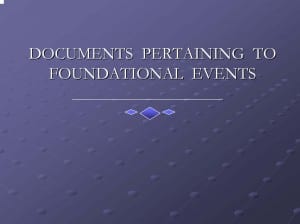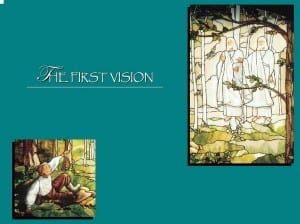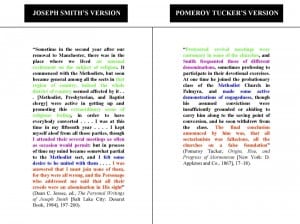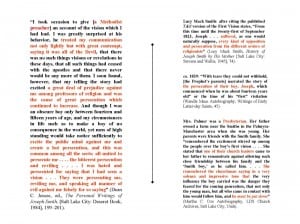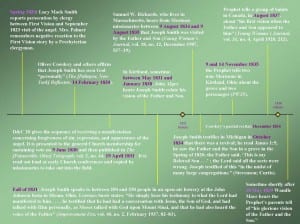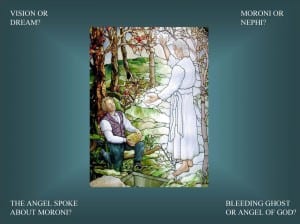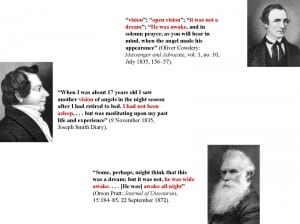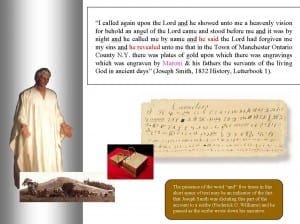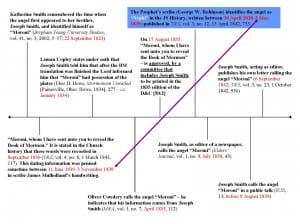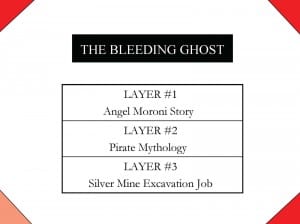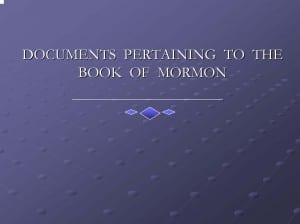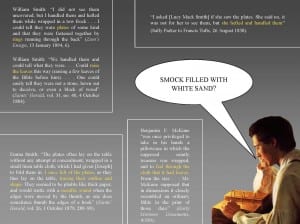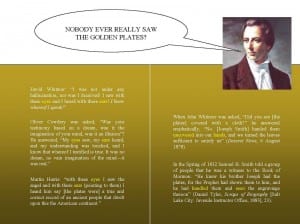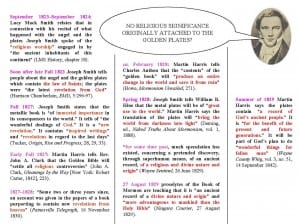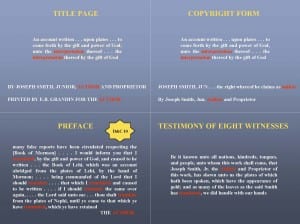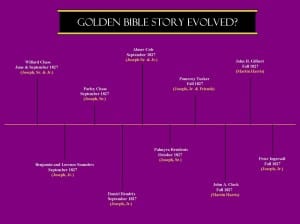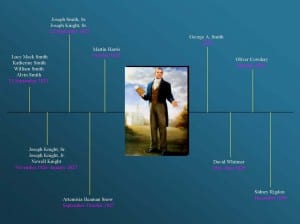Editor’s Note: The PowerPoint slides that accompanied this presentation have been incorporated into this page. Small versions of the slides are shown; if you would like to see larger versions of the slides, just click on the ones you want enlarged. -ed.
One bright, beautiful Sunday morning, everyone in the tiny town of Riverton woke up and went to the local church. Before the services started, the townspeople sat in their pews and talked with each other about their lives and their families.
Suddenly, at the front of the church, Satan appeared! Everyone started screaming and running for the door, trampling on each other in a determined effort to get away from Evil Incarnate. Soon everyone was evacuated from the church except for one man, who sat calmly in his seat, seemingly oblivious to the fact that God’s arch enemy was standing in his presence. This confused Satan a bit. The Adversary walked up to the man and said, “Hey, don’t you know who I am?” The man responded, “Yep, sure do.”
Satan asked, “Well, aren’t you terrified like the others?” The man answered, “Nope, sure ain’t.”
Satan became quite agitated at this point and demanded, “Why aren’t you afraid of me?” The man replied, “Well, I’ve been married to your sister for twenty-five years.”
The man in this story was not disturbed by the circumstance that he found himself in because, unlike the other people in the congregation, he had a unique perspective based upon his own personal experience. This story can be effectively compared to anti-Mormon literature that deals with Church history. Some people become aware of the content of antagonistic papers, books and pamphlets and run from the building in a state of terror. Others sit calmly in their seats because they have learned through years of dedicated study that these are not the carefully-researched, accurate and objective publications that they claim to be. They have learned that when it comes to documentary sources related to Mormonism’s past anti-Mormons rarely, if ever, allow their audience to see and weigh all of the available evidence.
In this presentation I would like to focus on how anti-Mormons present a fragmentary, one-sided, and often distorted view of the Prophet Joseph Smith through the selective use of documents. This is a very broad topic and so because of space limitations I will only be sharing a small part of the research that I have conducted in this area. I believe that by the end of this paper you will see that while anti-Mormons like to claim that their version of Joseph Smith’s story is ‘historical‘ it can actually be quite ‘hysterical‘ for those who have taken the time to closely examine the relevant documents.
Documents Pertaining to Character
I would like to begin by taking a look at certain aspects of Joseph Smith’s character. This subject is a prime target for anti-Mormon writers because they believe that if it can be demonstrated that the Prophet was a detestable, low-life scoundrel then doubt can be cast upon his claims about the Restoration. But in their zeal to attack the Prophet’s character anti-Mormons conveniently ignore a large amount of contrary evidence.
One recent anti-Mormon book cites a statement made in 1831 by Abner Cole who said that it was “quite certain that the prophet himself never made any serious pretensions to religion until his late pretended revelation”–meaning the Book of Mormon.1 It does not seem to concern modern anti-Mormons that Mr. Cole did not bother to explain how this determination was made or that his statement is directly contradicted by the information on this slide.
Here we see that Joseph Smith was raised in a very religious environment. He was taught at a young age to love God with all his heart.2 He learned from the Bible in his home,3 sang hymns, and participated in family prayers (both morning and evening).4 One firsthand account of what went on in the Smith household indicates that this family was “educated under the teaching of the strictest kind of a religious influence.”5 But on a more personal level, Father Smith recalled that during his childhood Joseph, Jr. “meditated much” upon the great things of the Lord’s law.6 And Joseph’s mother remembered that before 1823 he reflected “more deeply than common persons of his age upon everything of a religious nature.”7 The Prophet’s brother William further relates that between 1823 and 1827 he received “frequent lectures” from Joseph on the subject of religion.8 Where does all of this eyewitness evidence leave Abner Cole’s insistence that Joseph Smith was not seriously religious in his younger yearsó In an indefensible position.
Next, there is the anti-Mormon accusation that Joseph Smith’s behavior was so scandalous during his youth that Church leaders changed his official history after he died in order to cover up his misdeeds and ‘purify’ his character. The evidence offered in support of this claim is the history that is now published in the Pearl of Great Price, which can be seen on the left-hand portion of this slide. It is claimed that the words highlighted in red were fraudulently added to the text. These words, as the critics are eager to point out, were not in the 1842 version of the Church history as printed in the Times and Seasons.9 But what they fail to mention is that the portion in red was written on 2 December 1842 (while Joseph Smith was still alive and kicking and just months after his official history had been printed). In addition, they fail to acknowledge that these words are in the handwriting of Willard Richards, who served as the Prophet’s private clerk and scribe. It should also be noted that this material is written in the first person, which means that Joseph Smith is most likely the source of these words.
But critics take the charge of tampering with this text even further. They point out that the word “foibles” was inserted into the original manuscript as a replacement for the word “corruption” and the phrase “to the gratification of many appetites”–though present in the original manuscript–has been completely deleted in the Pearl of Great Price. I would respond that if these editorial adjustments were really meant to cover up embarrassing facts about the Prophet’s youth then the perpetrators did a very poor job of it since the original manuscript version was, in fact, published before the world in 1842 (both in the United States and in England) and reprinted in various pro-Mormon publications in 1878, 1882, 1883, and 1909.10 Tampering? Not hardly. Cover-up? The evidence refutes such an idea.
Some anti-Mormons have gone so far as to interpret some wording that is found in the 1842 published history to mean that when Joseph Smith was between ten and twenty-one years of age he “abandoned himself freely to a variety of youthful vices.”11 But this view is directly challenged by a letter that was published by Joseph Smith in December 1834. In this document–which is reproduced here on this slide–the Prophet acknowledges that between the ages of ten and twenty-one he “fell into many vices and follies.” But he refutes accusations of engaging in “gross and outrageous violations of the peace and good order of the community.” He also denies charges of “wrongdoing” and declares himself innocent of “injuring any man or society of men.” So what exactly were his “vices and follies”? He states quite clearly in this letter that he had a “light and too often vain mind,” an “uncircumspect walk,” and participated in “foolish and trifling conversation.”12 This doesn’t exactly sound like young Joseph was the appalling reprobate that anti-Mormons make him out to be. It sounds much more like a typical teenage boy who doesn’t take heed to the consequences of his actions or to the appropriateness of some of his verbal expressions.
What about the argument put forward by some critics that when Joseph Smith was young he was a ‘teller-of-tall-tales’? The argument is made that since Joseph had such an active imagination he could have easily made up the content of the Book of Mormon plus all of the Doctrine and Covenants revelations that he produced. The primary piece of evidence used in support of this contention is a quote from Lucy Mack Smith which is found in her dictated history and can also be seen on the right-hand portion of this slide.13
Two pieces of crucial evidence are typically ignored when this particular argument is advocated. Number 1: In the paragraphs that directly precede this quotation Mother Smith clearly provides its proper context. She indicates that Joseph’s stories are connected with the angel and the plates of the Book of Mormon. Number 2: About seven years before the Prophet’s mother dictated this particular statement for her history she told the same basic information to Wandle Mace. But on this occasion she specified that Joseph’s stories were about the “Nephites” and she also pointed out that Joseph had learned this information through the aid of visions.14 This detail about being shown Book of Mormon events in vision is confirmed in the Prophet’s own published history.15 Therefore, the idea that Joseph Smith was simply making these stories up out of his own active imagination is not sustained by the available evidence.
Another favorite assertion of anti-Mormons is that Joseph Smith was a lazy individual who went out of his way to avoid manual labor (both as a youth and as an adult). Documents produced by nineteenth-century critics such as David Stafford, Joseph Capron, Daniel Hendrix and Parley Chase are usually called forth in order to substantiate this claim.16 This is one of those charges that is hysterically funny to those researchers who are familiar with early LDS documents. As can be seen by the timeline on the screen, Joseph Smith was a hard worker throughout his entire life and he worked especially hard during the Nauvoo period of Church history.17 The quotations found on the bottom of this slide should make modern anti-Mormons think twice about putting any stock in the lazy prophet argument. They come from eyewitnesses to Joseph Smith’s work ethic and say things such as, “He enjoyed doing hard physical labor, Öany kind of work that needed to be done”; “he assisted in mowing grass, with a scythe, many a day, putting in ten hours good hard work”; “He was strong and active, and could build more rods of good fence in one day than most men could do in two.”18 When the Prophet’s brother William was questioned about the accusation that Joseph was a lazy person he made these insightful comments:
“We never heard of such a thing until after Joseph told his vision, and not then, by our friends. Whenever the neighbors wanted a good day’s work done they knew where they could get a good hand and they were not particular to take any of the other boys before Joseph eitherÖ Joseph did his share of the work with the rest of the boys. We never knew we were bad folks until Joseph told his vision.”19
In the early stages of the Restoration critics of the Prophet attempted to get people to ignore his message by claiming that he was “not a man of truth and veracity.”20 Parley Chase was one of those individuals. He published a statement that declared the Prophet “bore the reputation among his neighbors of being a liar.”21
Did all of Joseph’s neighbors believe that he was a liaró Certainly not. Mrs. Palmer, a non-Mormon who lived near the Smith farm in Palmyra, said that before the Spring of 1820 “there was never a truerÖboy than Joseph Smith.”22 Those people who had close, extended contact with Joseph also made note of his honesty. The Prophet’s younger brother William reports that in accordance with “religious training of the strictest sense, the order of [the Smith] family was truthfulness.”23 William mentions that up to 1823, when Joseph was seventeen years old, the family had “implicit confidence in what he said.” Why? Because “he was a truthful boy.” William also made this noteworthy comment. He said, “I suppose if he had told crooked stories about other things we might have doubted his word about the plates [of the Book of Mormon], but Joseph was a truthful boy.”24 The Knight family of Colesville, New York had extensive contact with Joseph when he was about twenty-one year of age and they “found him [to be] a boy of truth.”25 And in 1830 Josiah Stowell was willing to testify in a court of law that he was “well acquainted” with Joseph and knew him to be honest.26 Oliver Cowdery informs us that he interviewed “many persons” with whom he had been intimately acquainted and knew to be individuals of unquestionable integrity. He learned from their lips that Joseph Smith had been “an honest young man,” even “a young man of truth.”27 And finally, there is the statement of Lorenzo Snow, who knew the Prophet intimately from 1832 until 1844. He said, “I knew him to beÖhonest in all his endeavorsÖ I bear testimony of his honesty.”28
What about the assertion that Joseph Smith was a mean kid29 and a violent adultó Again, these charges are called into question by contrary evidence. Joseph’s own mother said that her son was “a remarkably quiet, well disposed child” up through the age of fourteen.30 Pomeroy Tucker, a non-Mormon who knew Joseph during his youth recalled that “He was…prover[bially] good-natured, very rarely if ever indulging in any combative spirit toward anyone, whatever might be the provocation.”31 Lydia Knight (in the 1830’s) and Margaret Young and William Appleby (in the 1840’s) all noted that the Prophet’s manners were mild and “gentle.”32 And just days before Joseph Smith died he was described by John Bernhisel as having a heart that was “keenly alive to the kindest and softest emotions of which human nature is susceptible.”33
In light of these and other testimonies, how should a person react to the claim that Joseph Smith was so violently inclined as an adult that he once beat up a Baptist minister simply for doubting that he had seen Jesus Christ? Answer: with a heavy dose of skepticism! On this slide you will see a quotation from Jedediah M. Grant.34 One anti-Mormon publication has recently used this quote in an attempt to give substance to the myth that Joseph Smith was a violent man. I have highlighted important parts of this quotation so that the next time critics of the Church read it they will perhaps have a better chance at comprehending what it says. When this quotation is read with care, it is clear that it has absolutely nothing to do with Joseph Smith beating up a Baptist priest. It is talking, in rather colorful frontier phraseology, about piety and how the Baptist priest’s piety got bent out of shape over the Prophet’s invitation to wrestle with him. It is true that Joseph Smith defended himself on occasion with physical force and even kicked a man out of his houseóliterallyófor insulting him and the Lord’s latter-day work. But an 1834 proclamation published by Joseph Smith needs to be taken into serious consideration whenever it is claimed that he was habitually inclined to violence. Joseph stated that it could not be sustained, in truth, that he had been guilty of “injuring any man or society of men.”35 And Oliver Cowdery amplified this statement, just one year later, by declaring that Joseph Smith “never injured any man in either property or person.”36
The last topic that I would like to address in the category of “Documents Pertaining to Character” has to do with Joseph Smith’s morality. Some of the Prophet’s more unfriendly neighbors in the Palmyra, New York area claimed that during the time he lived in their midst he was “entirely destitute of moral character.”37 But this charge simply doesn’t square with some of the documentary sources that are available. For instance, a non-Mormon named Orsamus Turner reminisced that during Joseph’s time in Palmyra he helped a juvenile debate club solve significant questions of a “moral” nature.38 Oliver Cowdery reported in print that he had interviewed many people who testified to him that Joseph Smith was an “upright, virtuousÖyoung man.”39 Charles B. Thompson wrote that Joseph “was by nature no better than any other boy” and had his share of “imperfections.” But, said Charles, the Prophet was not “guilty of all the immoralities alleged against him.” Like Oliver, Charles heard eyewitness accounts that contradicted such an idea. He said, “I have the testimony of those that I know to be good, respectable people, who have been acquainted with [Joseph] from his childhood, and their testimony is that ‘he never has been guilty of any immoralities which are not common to youth.'” Charles further states that he had been personally acquainted with Joseph Smith from 1836 to 1841 and was a “witness” that he had not been guilty of immoral conduct as long as he had known him.40
Another person who was a witness of the Prophet’s moral character during his adult years was Lorenzo Snow. He knew Joseph Smith as a close associate from 1832 until 1844 and made this informed remark: “No one [who] was as intimately acquainted with him as I was could find any fault with him, so far as his moral character was concerned.”41 And there was yet another close associate of the Prophet’s who provided important testimony on this subject. John Taylor said,
I was acquainted with Joseph Smith for years. I have traveled with him; I have been with him in private and in public; I have associated with him in councils of all kinds; I have listened hundreds of times to his public teachings, and his advice to his friends and associates of a more private nature. I have been at his house and seen his deportment in his familyÖ I have seen him, then, under these various circumstances, and I testify before God, angels, and men, that he was a good, honorable, virtuous manÖthat his private and public character was unimpeachable.42
Now, I have no doubt that when anti-Mormons look at all of the preceding evidence regarding Joseph Smith’s character they will simply brush most of it aside, claiming that the statements given by Latter-day Saints cannot be relied upon because their views are biased. In response, I would like to point out the documents on this slide. Here we have four instances where Joseph Smith’s non-Mormon neighbors in the Palmyra-Manchester area were interviewed about his character between 1830 and 1835. Sidney Rigdon and Edward Partridge conducted interviews in the Manchester area in late 1830 and Sidney is quoted in a February 1831 newspaper article as saying that he couldn’t even find an enemy of Joseph Smith who could degrade his character.43 In May of 1833 Joseph Holbrook and Truman O. Angell went to the town of Manchester and were told by a gentleman who lived there that he did not know of any harm coming from the Prophet until after he brought forth the Book of Mormon.44 In September of 1833 John Carter talked with many people in the Manchester area and found that even though they disliked the Prophet they were unable to bring forth anything substantial against him.45 And in May of 1835 Jonathan Hale went from house to house in Palmyra and was told that before the Prophet received the Book of Mormon plates “his character was as good as young men in general.”46
Documents Pertaining to Foundational Events
The next category that I would like to explore is “Documents Pertaining to Foundational Events.” Again, because of space constraints, I will only be addressing a few of the many topics that could be covered in this category. I have decided to address issues that are related to the First Vision and the angel Moroni.
The First Vision is treated as a subject of great controversy in anti-Mormon literature and the things that are said about it by critics of the Church deserve to be carefully scrutinized. I would like to briefly examine a few of the many claims that are made about this event including the alleged unreliability of Joseph Smith’s 1838 account of this vision, the claim that the general membership of the Church didn’t even know about this event until 1840, and the assertion that Joseph Smith joined the Methodist and Baptist churches after he was supposedly forbidden from doing so during this manifestation.
On this slide I have color-coded the information in the two columns so you can see that each of the main themes of Joseph Smith’s 1838 First Vision account47 are repeated, in the very same sequence, in the writings of a non-Mormon named Pomeroy Tucker. Mr. Tucker was born in Palmyra, New York in 1802 and apparently lived there up through his apprenticeship at the Palmyra Register newspaper around 1820. He claimed that he had knowledge of the Smith family beginning with their move to Palmyra in 1816 through their relocation to the town of Manchesterówhere the First Vision took place.48 Since Pomeroy lived in the right place during the right time period his recollections are of special interest, as they appear to confirm the reliability of Joseph’s report.
On the slide we see the following sequence. In Green: Joseph Smith states that there was an unusual religious excitement in his locality which spread to the surrounding region; Pomeroy Tucker reports that different churches were holding “protracted revival meetings.” In Purple: Joseph Smith says he attended these meetings as he found the time; Pomeroy Tucker confirms this fact. In Blue: Joseph Smith indicates that he became partial to the Methodist sect; Pomeroy Tucker notes that Joseph joined the Methodist probationary class and was actively engaged in it. In Red: Joseph Smith states that during the First Vision he was told that “all” the churches were wrong and he was instructed not to join any of them; Pomeroy Tucker reports that Joseph not only withdrew from the Methodist probationary class but announced that “all” the churches were in error.
In the left hand column of this slide is another part of Joseph Smith’s 1838 First Vision account. The words highlighted in red represent the Prophet’s claim that he was persecuted for telling other people about his experience. One recent anti-Mormon book asserts that there is no evidence that any such persecution took place and that when Joseph produced his 1838 history he simply added this material for the sake of drama. But this view is not sustained by documentary sources. In fact, we see three quotations in the right-hand column that effectively nullify it. The second quote shows that the Prophet’s parents verified that their son was persecuted after his “first” visitation from heaven took place in 1820.49 The third quotation is especially interesting because it reports the words of a non-Mormon neighbor of the Smiths who witnessed the reaction of one of these persecutors. This neighbor relates that after the “first vision” occurred a Presbyterian church leader came to her house and admonished her father not to let his family associate with the “Smith boy” any longer. The churchman insisted that Joseph “must be put down” or else he would someday convince others to follow after him.50 And, of course, that proved to be the case.
One recent anti-Mormon publication has argued that the traditional story of the First Vision didn’t even exist until it was written down in 1838 and wasn’t well known among Latter-day Saints until 1840, when Orson Pratt published it for the first time. The theory of Joseph’s detractors is that the First Vision story was simply invented as an afterthought in the grand scheme of the Restoration scam. But on this slide we see a great deal of evidence to the contrary. From this timeline we learn that in February 1830 Joseph Smith’s own hometown newspaper announced that he had seen God “personally.”51 And in the following decade Joseph Smith and the missionaries of the Church taught Mormons and non-Mormons alike about the appearance of the Father and the Son in a grove of trees in the year 1820. These sources even report that the phrase made famous in the Prophet’s 1838 accountó”This is my Beloved Son, hear him”ówas definitely known during this timeframe. Was Joseph’s sacred experience related to only a few individualsó No. In fact, just the opposite is true. In 1831 the Prophet told a crowd of nearly 250 people about this glorious manifestation52 and in 1834 we know that he related it in the midst of “many large congregations.”53
Anti-Mormons like to point to nineteenth-century sources that claim Joseph Smith became a Methodist exhorter around 1821, a Baptist convert around 1824, and then a member of the Methodist church again in 1828. The argument is made that these actions show the Prophet really wasn’t commanded in 1820 by the Father and the Son not to join any of the churches and therefore he must have fabricated the whole story. Let us take a look at these allegations in their order.
First, there is the assertion that Joseph became a Methodist exhorter around 1821. The evidence used to justify this claim is a quotation from Orsamus Turner,54 which is found on the left-hand portion of this slide. I am confident that anti-Mormons have misinterpreted this source, just like the Jedediah M. Grant quote that was mentioned earlier. I contend that this source is not talking about Joseph Smith acting as an exhorter in evening meetings of the Methodist denomination but rather the evening meetings spoken of were the gatherings of the juvenile debate club. This conclusion is supported by a newspaper article in the Western Farmer which announced that the Palmyra debate club would begin meeting in the local schoolhouse on 25 January 1822.55 We learn from firsthand witnesses that children attended school in Palmyra during the winter months and through the end of March.56 Since school was in session during the same time period when the debate club was meeting it would not be possible for them occupy the same building at the same time. Therefore, the debate club would have to meet at the schoolhouse during evening hours. It should also be noted that no anti-Mormon has ever bothered to explain just how Joseph Smith became a Methodist exhorter without first becoming a Methodist. And remember, Pomeroy Tucker stated quite clearly in his book that even though Joseph attended Methodist meetings he did not convert to that faith.57
What about Fayette Lapham’s claim that Father Smith told him around 1830 that his son had joined the Baptist church around 1824? Mr. Lapham made this claim in 1870, which was 40 years after Father Smith allegedly told him such a thing.58 This claim cannot be taken seriously since no official record of Joseph Smith’s baptism into the Baptist church has ever been produced and nobody else ever mentioned this conversion except for Fayette Lapham. It should also be noted that according to Josiah Stowell, Jr., Joseph Smith “did not profess religion” when he was “20 years old or thereabout”ómeaning that he did not belong to any church around the year 1826.59 If Joseph had become a Baptist around 1824 we would expect him to declare as much to Josiah, Jr., just two years later. Mr. Lapham’s memory is simply not supported by documentary sources. There is no verifiable evidence that Joseph Smith ever became a Baptist.
Now, what about the charge that the Prophet sought membership in the Methodist Episcopal church in June of 1828? Anti-Mormons try to support this idea by citing a joint statement published by Joseph and Hiel Lewis who contended, nearly 51 years after the fact, that the Prophet sought to join the Methodist Episcopal church in Harmony, Pennsylvania at the same time that he was “translating his gold bible.”60 But as can be seen on this slide, Michael Morse–the Methodist class leader in Harmony, Pennsylvania at the time that this alleged event took place–stated unambiguously that Joseph Smith “did not seek to become a full member” of the Methodist church.61 The Prophet did indeed attend Methodist gatherings in Harmony while he was living there but the question must be asked, ‘Did he do so with the intent of converting?’ This is exceedingly unlikely. Why? Because Joseph declared to one of the residents of Harmony, sometime between late December 1827 and May 1829 that he “was a prophet sent by God” to convert other people.62 Furthermore, it is recorded in one historical document that during Joseph’s stay in Harmony he “undertook to make a convert” of Nathaniel Lewis (who was a deacon in the local Methodist church and also the father of Joseph and Hiel Lewis). Nathaniel said that he would become one of Joseph’s “disciples” if he could test the “spectacles” that the Prophet was using to “translate” the “Golden Bible”óbut Joseph declined his offer.63 Finally, let us not overlook the reference found in section 10 of the Doctrine and Covenants where, in the Summer of 1828, the Lord told Joseph Smith that He would establish His Church in that generation if the people would not harden their hearts. With this prospect looming on the horizon, why in the world would the Prophet have the need or the desire to join any other church?
Let’s move on now to anti-Mormon claims connected with the angel Moroni. In this section I would like to say a few words about the notion that Joseph Smith had a dream about the angel instead of a vision, the argument that the personage appearing to the Prophet couldn’t have been Moroni since he spoke about Moroni, the assertion that Joseph couldn’t decide whether to call the angel Moroni or Nephi, and the very strange idea that the Prophet learned about the golden plates from a bleeding Spanish ghost.
There is a group of nineteenth century non-Mormon documents that say Joseph Smith learned about the existence of the golden plates in a dream instead of in a vision.64 Critics point to these documents and proclaim that the Prophet didn’t have a real-world experience with a heavenly beingóit all just happened in the recesses of his subconscious mind. But on this slide you will see that the ‘dream’ notion was formally refuted in the Church’s official newspaper in July 1835. Oliver Cowdery, who spoke with Joseph Smith on this subject sometime before committing his words to paper, referred to the experience as an “open vision.” He noted that Joseph was definitely “awake” because he was praying at the time. This experience, said Oliver, was “not a dream.”65 The Prophet confirmed these points just a few months later when he recorded in his diary that he had “not been asleep” before this manifestation took place, and classified the experience as a “vision.”66
Anti-Mormons, of course, will not be convinced by these statements. They will point out that Oliver Cowdery’s refutation was printed six years after the first ‘dream’ document appeared in print. But, as can be seen by the information on this timeline, the Prophet had been teaching members of his family and his close associates since 1823 that he had been visited “in person” by a heavenly messenger, and he classified this experience as a “vision.”67 It is also important to see on this slide that before the first ‘dream’ document showed up in the newspapers in 1829 Daniel Hendrix (in Palmyra)68 and Thurlow Weed (in Rochester)69 were both told by Joseph Smith himself that he had had a “vision,” not a dream. And David Whitmer heard the angelic experience characterized as a “vision” when he spoke with the townspeople of Palmyra in early 1828.70 The information located on the lower right-hand corner of this slide is of special interest. Here we find reference to the first ‘dream’ document in late August 1829. But notice that the person who produced this document Jonathan A. Hadley admitted years later that during this same time period (Summer 1829) Martin Harris told him that Joseph Smith was sure that his experience was not a dream. Now look at the upper right-hand corner of this slide. Here we see that in 1831 (two years after the first ‘dream’ document appeared) non-Mormon newspaper editor Orsamus Turner was not sure whether he should describe Joseph’s experience as “a dream, or vision.”71 When the ‘dream’ documents are seen in their proper historical context they become much less impressive than the anti-Mormons make them out to be.
On this next slide you will see a short quotation taken from the Prophet’s 1832 history.72 Critics like to draw attention to this text because in their minds if the angel who appeared to Joseph Smith spoke about plates that had been engraved by Moroni then that particular angel could not have been Moroni. They see this as evidence that the Prophet changed the identity of the heavenly messenger when he recorded this experience again in 1838. But the naysayers fail to acknowledge that these words are not in the handwriting of Joseph Smith; they were written by Frederick G. Williams who was a relatively recent convert to the Church. Since Joseph was telling this story to a scribe who was also a recent convert he probably phrased it differently than he would have if he had written down the account himself. Indeed, it appears that the Prophet was explaining, as well as reciting, this event to Williams. Notice in this text that even though the angel “said” that Joseph’s sins had been forgiven by the Lord the material after that point is a summary of things that were “revealed” by the angel. The mention of the plates engraved by Moroni is located in the summary section of this text and is not represented as a direct quotation from the angel. Therefore, the contention that the angel spoke about Moroni is simply a mis-interpretation and mis-representation of what the text actually says.
The next topic that we will take a look at is the ‘Nephi vs. Moroni’ controversy. The primary document of concern in this case is Joseph Smith’s 1838 manuscript history. In this handwritten record the angel that revealed the golden plates of the Book of Mormon is identified as Nephi instead of Moroni.73 When the history of the Church was first published in the Times and Seasons newspaper in 1842 this designation was retained74 and then there were several subsequent LDS sources that copied, and therefore repeated, the Times and Seasons designation.
The explanation for this anomaly is really quite simple. Joseph Smith did not write the section of his 1838 history where the angel is called Nephi. This section is in the handwriting of George W. Robinson who served as one of the Prophet’s scribes. As Apostle Orson Pratt explained, the Nephi designation represents either carelessness or ignorance on the part of the transcriber.75 This explanation is supported by the information presented on this slide. It is clear from the entries seen here that Joseph Smith consistently identified the angel as Moroni in 1823, 1830, 1834, 1835, 1838, 1839 and 1842. The dates that are pointed out by the purple line show that only months after the angel was incorrectly identified in the manuscript history as Nephi by George Robinson he was correctly identified as Moroni by James Mulholland–another scribe who was working on the Church history project.
Anti-Mormons think that since Joseph Smith was acting as the editor of the Times and Seasons newspaper when the “Nephi” designation was published he would have changed it if he had thought it was not correct. But a quick check of the History of the Church reveals that the Prophet probably didn’t have sufficient time to scrutinize this portion of his history before it went to press. On the day before publication he was occupied with the legalities of a bankruptcy proceeding. On the day of publication he was “busily engaged” in the same type of activity plus he had to write a lengthy article on Baptism for the Dead for the very same edition of the paper that was about to incorrectly identify the angel as Nephi.76
Critics of the Prophet believe that if he really thought the Nephi designation was incorrect then he would have published a retraction. But since none was ever forthcoming they think he changed his mind about the angel’s identity. A popular English dictionary from 1828 defines the word retraction as “The act of withdrawing something advanced, or changing something done.”77 Based upon this definition I contend that Joseph Smith did indeed publish a retraction. The Nephi designation went out in the 15 April 1842 edition of the Times and Seasons and then in the 1 October 1842 edition of the same paper the Prophet (still acting as the editor) published a letter, written by himself, wherein he identified the angel as Moroni. This is most definitely a change from what had previously been done and thus qualifies, in the strict dictionary sense, as a retraction.
Before leaving this section of the paper I would like to offer a brief analysis of a story that claims a bleeding ghost told Joseph Smith about the golden plates instead of an angel of God.
The Prophet stated that by August 1829 there were “many false reports” being circulated about the Book of Mormon.78 I would classify the tale of the bleeding ghost among them. There are only four sources for this story that I am aware of and they are all very late, being committed to paper between 1870 and 1880.79 In studying this story I believe I have detected three separate layers of information connected with it.
- Layer #1. Joseph Smith’s account of the angel Moroni visit. Anyone who is familiar with Joseph Smith’s official version of events can easily see elements of it scattered throughout Fayette Lapham’s and Joseph and Hiel Lewis’s accounts of the bleeding ghost.
- Layer #2. Pirate mythology. Lapham and the Lewis brothers speak of a gold treasure that has been buried in an iron box. The hidden treasure is located by taking one’s bearings on certain landmarks. The ghost who guards the treasure has had his throat slit. The ghost reveals that he received his deadly wound when the treasure was first buried, “in order to prevent his making an improper disclosure” about its location (This is tantamount to saying, “Dead men tell no tales“). The only thing missing is an eye patch for the ghost and the theme music from Pirates of the Caribbean!
- Layer #3. Joseph Smith’s 1825 silver mine excavation job. It is well-known that in October 1825 Joseph Smith was hired by Josiah Stowell of South Bainbridge, New York to try and help him locate a buried silver mine that had been operated by the Spanish many years before.80 This is especially relevant because in both the Lewis and Frederic Mather accounts the bleeding ghost was a Spaniard! And it is interesting to note, and probably significant, that the Lewis brothers lived right in the same area where Joseph Smith was helping to locate the Spanish silver mine in 1825.
In light of the preceding evidence I think it is safe to say that the bleeding ghost yarn is a blending of elements from three different stories and I believe that it was the critics of Joseph Smith who did the blending. No nineteenth century LDS source that I am aware of ever mentions a bloody spirit in connection with the coming forth of the Book of Mormon. Elizabeth McKune (who happened to be the Lewis brothers’ sister) claimed that she heard Joseph Smith tell the bleeding ghost story in the Spring of 1828. But it can be plainly seen by the many entries on this timeline that Joseph and his close associates consistently told people between the years 1823 and 1830 that the personage the Prophet encountered was an angel of God, not a hemorrhaging specter. I would encourage anti-Mormons to closely study the material on this timeline and then abandon their wounded apparition. It doesn’t stand a ghost of a chance of being taken seriously by careful historical researchers.
Documents Pertaining to the Book Of Mormon
The last category that I would like to explore in this paper is “Documents Pertaining to the Book of Mormon.” I would like to examine the charge that the golden plates never really existed, the notion that Joseph Smith didn’t originally attach any religious significance to the volume, the claim that the Prophet was really the author of the Nephite text, and the idea that Joseph Smith’s story of the coming forth of the Book of Mormon evolved over time.
Proponents of the charge that the golden plates never really existed look to Peter Ingersoll as their champion. Ingersoll claimed that in the Fall of 1827 Joseph Smith confessed to him that he never actually had a Golden Bible in his possession but duped his family by telling them that several quarts of white sand wrapped in his work smock was a volume on the pre-Columbian inhabitants of the American continent. Joseph, according to Mr. Ingersoll, told his family that he was forbidden to display this ancient object on penalty of death, and thus nobody ever saw what was really in the smock.81
Peter Ingersoll’s prevarication can be easily dismissed by consulting the documents on the slide above. The ‘white sand hoax’ reportedly took place in the Fall of 1827 when the Prophet brought his work smock into the Smith family residence. But testimony from one of the people who was present on this occasion indicates that there was something much more substantial in the smock than just a bunch of sand. William Smith reports that even though he was not allowed to see the object that was inside the smock he was allowed to hold the package in his hands and when he did so he could feel individual plates and also the rings that were holding them together.82 The other members of the Smith family were also allowed to handle the package on this occasion and surely they could have told the difference between a rigid, rectangular object and a few quarts of finely pulverized rock. Emma Smith, the Prophet’s wife, once traced the outline of the book as it lay upon a table wrapped only in a linen cloth. She said that she could hear a metallic sound when she passed her finger across the edge of the plates.83 On the slide above you can see that even Benjamin McKuneówho was not sympathetic to Joseph or his causeótestified that in Harmony, Pennsylvania in 1828 he felt individual plates as he handled the Book of Mormon record through a piece of cloth.
Now, let us take a look at the related idea that none of the Book of Mormon witnesses ever actually saw the golden plates. It is claimed by some critics that since the Three Witnesses had a ‘visionary’ experience they did not actually view the plates with their natural sight, and therefore their testimony cannot be accepted as recounting something that happened in the real or empirical world. Critics typically construct their ‘visionary’ argument using second-hand accounts of things that Martin Harris supposedly said. These retellings originated with opponents of the LDS faith such as Stephen Burnett, Jesse Townsend, Anthony Metcalf and John Gilbert.84
In response to this accusation I would like to point out the three quotations on the left-hand portion of this slide. Here you will see statements from each of the Three Witnesses which were recorded by persons who were not antagonistic toward Mormonism. I have highlighted words that I would like to draw your attention to. Here we see that each of the Three Witnesses testified, independent of each other and at different times, that their experience was registered by both their physical “eyes” and “ears.”85 In addition, David Whitmer provided an invaluable perspective on the nature of the Three Witnesses’ experience when he said,
Of course we were in the Spirit when we had the view, for no man can behold the face of an angel, except in a spiritual view. But we were in the body also, and everything was as natural to us, as it is at any time.86
As the documents on this slide show, the witnesses were careful to clarify that they were not fooled by an illusion, they were not suffering from any type of hallucination, and they most certainly were not having a dream.
Modern anti-Mormons claim that as far as the Eight Witnesses are concerned, none of them saw the golden plates either–they only saw an object that was covered over with a cloth! But take a look at what two of the Eight Witnesses had to say about their experience and determine whether or not the anti-Mormon view can be sustained. When John Whitmer was asked point blank, “Did you see [the plates] covered with a clothó” He answered, “No. [Joseph Smith] handed them uncovered into our hands, and we turned the leaves sufficient to satisfy us.” In this same interview John Whitmer stated that the plates were a material substance, they were gold, they were heavy, they measured 8 by 6 or 7 inches, they had engravings on both sides, and they were connected together by three rings in the shape of the letter D.87 In the Spring of 1832 Samuel H. Smith (the Prophet’s younger brother) informed a group of people that he was a witness to the Book of Mormon. He said “he knew his brother Joseph had the plates, for the Prophet had shown them to him, and he had handled them and seen the engravings thereon.”88 These men obviously saw and handled an identifiable, physical object and were able to supply a detailed description of it. The anti-Mormon stance on this issue simply cannot be taken with any degree of seriousness.
As a side note, I would like to draw attention to the attempt made by some anti-Mormons to ‘qualify’ the published testimonies of Joseph Smith, Sr., Hyrum Smith and Samuel Smith by appealing to a statement made by William Smithówho did in fact speak of these men handling the plates while they were concealed by a piece of cloth.89 This is a prime example of the type of ‘hysterical but not historical‘ scholarship that some critics of the Church engage in. William’s statement refers only to his brother bringing the golden plates into his family’s home in late September 1827, not to the experience of the Eight Witnesses which occurred in June 1829. Anti-Mormons would do well to educate themselves on this point so that they can avoid any future embarrassment by employing this bogus argument.
Some critics claim that Joseph Smith did not assign any religious significance to his book of gold plates until sometime between 1828 and 1830. They present the writings of such people as Daniel Hendrix, Joseph Capron, and Joseph and Hiel Lewis to lend support to their contention.90
But once again, the historical record does not support such an idea. All anyone needs to do to refute this notion is open the pages of Lucy Mack Smith’s unedited autobiography. Mother Smith reports that shortly after 22 September 1823 Joseph told the members of his family about the “religious worship” that was carried out by the “ancient inhabitants of this continent” and his recital of these things was directly connected with his encounter with the angel and the revelation of the existence of the golden plates. Mother Smith reports that because of what Joseph told his family at this time they were “convinced that God was about to bring to light something that [they] might stay [their] minds upon,” something more definite than anything they had been previously taught.91 As the other quotations on this slide demonstrate, the golden plates were clearly and consistently associated with the concepts of religion and salvation from 1823 through 1829. Those who accepted Joseph’s claims were aware of this connection, as were those who rejected his claims. In light of this information it must be concluded that the anti-Mormon argument regarding this issue is not accurate and should therefore be rejected by serious students of history.
Anti-Mormons have long argued that Joseph Smith must have been the creator of the Book of Mormon text since he is identified as the “Author” on the title page and in other sections of the first edition. Critics are eager to point out that in the next edition (which was printed in 1837) the Prophet’s designation was changed to “Translator,” and in their minds this is evidence of a cover-up.
But, as usual, the critics have ignored several important points in connection with this matter. Both the Copyright Act of 1790 and the supplementary Act of 1802 referred numerous times to the rights granted to an “author or proprietor” of a book but no provision was made in either of these edicts for the copyright holder to be designated as a translator. Translation rights were not addressed in American copyright law until the year 1870. As can be seen on this slide, the only option presented to the applicant in the bottom pre-printed section of the copyright form was to declare oneself as an author or a proprietor. When the Book of Mormon copyright application was filled out on 11 June 1829 Joseph Smith was listed in the top section as the “author” of the volume. This designation is not in the handwriting of Joseph Smith and may, therefore, have been assigned by the clerk of the district court. But notice that in the descriptive section that was to be filled out by the applicant Joseph Smith is identified as both the “author and proprietor.” This means that the Prophet, or possibly an agent who was sent to transact this business at the copyright office, chose to claim all of the rights allowable by law. The reason why this particular action was taken is currently unknown.
Even though Joseph Smith was identified as the author a total of six times in the 1830 edition of the Book of Mormon he also provided information, within this very same edition, that clarified what this term meant in relation to him. On this slide we see that both on the title page and on the copyright notice the Prophet published the same description of the content of the plates which he said he translated from the last leaf of the unsealed portion of the Book of Mormon.92 This description, which was written in ancient times, foretells that the modern text would be derived through the process of interpreting the plates. It is further indicated that the interpretation would be brought about by the gift and power of God. So, even though Joseph Smith is identified on both of these pages as the author of the Book of Mormon it is also specified that the text was derived through a divinely-assisted interpretive process. In the other two portions of the 1830 Book of Mormon where Joseph Smith is identified as the “author” there are even more specific clarifications of this term. In the Preface, for instance, it is indicated no less than six times that Joseph Smith translated the book. It should be noted that portions of the Preface were derived from section 10 of the Doctrine and Covenants and in that section, which is traditionally dated to the Summer of 1828, there are 13 separate references to Joseph Smith translating the Book of Mormon text.93 And finally, there is the Testimony of the Eight Witnesses. In the 1830 rendition of this document it is clearly stated that the Prophet “translated” the golden plates, even though he is also designated as the “Author” of the book. To recap, in all four documents in the 1830 edition of the Book of Mormon where Joseph Smith is identified as the author of the text there is also a clarification that he is the interpreter or translator of the text. When the Prophet was listed as the “Translator” on the title page of the 1837 edition of the Book of Mormon it was nothing new.
I will end this paper by briefly discussing the anti-Mormon theory that Joseph Smith’s account of the coming forth of the Book of Mormon evolved over time. The words of nineteenth-century critic Parley Chase are representative of this view. He stated in an 1833 affidavit that, “In regard to their Gold Bible speculation, [the Smith family] scarcely ever told two stories alike.”94
Unfortunately for anti-Mormons, the credibility of the ‘revision theory’ is seriously damaged by the very same collection of documents that they have used to construct it. On the timeline that is found on this slide I have plotted out a set of non-Mormon individuals who recited what Joseph Smith, Jr. and his close associates told them about the coming forth of the Book of Mormon in the year 1827. I have also prepared other slides which are not shown here but which cover the years 1828 through 1830. If anyone will put forth the effort to carefully examine the content of all the relevant documents that are connected with these non-Mormon individuals they will see a hitherto unrecognized pattern emerge; they will see a nearly complete version of the story that Joseph Smith published before the world in the mid-1830’s and early-1840’s. In other words, these non-Mormon documents have preserved and confirmed the traditional LDS version of events. Following is a summary of things that Joseph Smith, Jr., his father, and Martin Harris reportedly said to people, who were not sympathetic to their cause, between June and December in the year 1827.95
- An angel told Joseph where he could procure a set of gold plates.
- The plates were concealed in a hill south of Palmyra, New York.
- The plates had beautiful engravings on both sides of them.
- The plates had three rings running through their back edges.
- The plates were a record of a group of ancient Israelites.
- The plates were “of immortal importance in [their] consequences to the world”; they “contained revelations in regard to the last days.”
- Joseph found a big pair of spectacles with the plates which were to be used to translate the plates.
- Joseph was told that “if he remained faithful, he would be the chosen prophet to translate [the plates for] the world.”
- In the forepart of September 1827 Joseph was expecting to obtain the set of gold plates soon and so he tried to obtain a chest to store them in.
- Joseph took his wife (at night, in the early morning hours) to the hill where the plates were hidden. They went to their destination in a one-horse wagon.
- When Joseph obtained the plates he was met by an angel and saw a multitude of devils who wanted to deter him.
- Joseph was instructed not to allow anybody else to see the plates or their would be a penalty of death.
- Joseph wrapped the plates in a piece of cloth before he brought them to his home.
- As Joseph was bringing the plates to his home somebody tried to take them from him. He knocked this person down and got away but had several other skirmishes as he continued toward his residence.
- Joseph was severely bruised by one of his attackers. When he finally made it to his home he was very fatigued.
- The plates were hidden underneath the hearthstone in the Smith family’s house.
- When Joseph moved from Palmyra, New York to Harmony, Pennsylvania at the end of 1827 he hid the plates in a barrel of beans in order to prevent them from being discovered.
I think that it is also important to mention that there is a collection of pro-Mormon documents (as represented here on this slide) which, when compared with the full range of relevant non-Mormon documents, demonstrate that Joseph Smith told the very same story to everyone about how the Book of Mormon came forth. If the pro-Mormon documents are taken to be the standard of judgment then it is easy to see that even though non-believers preserved numerous accurate elements of the Prophet’s story they also added a host of foreign elements to it through mis-remembrance, exaggeration, the perpetuation of rumor, and outright fabrication. I believe that the information contained in all of these documents will go a long way in dispelling the anti-Mormon ‘revision theory.’
Now let me refer once again to the story about Satan appearing in the church. Almost everybody abandoned the building in a state of terror when the Adversary appeared, but one man stayed firmly planted in his seat. He was not troubled by the situation that he was faced with because his personal experience had given him a different perspective than the others. It is my hope that all Latter-day Saints will become like this man. I hope they will take the opportunity to study the history of the Church and also the life of the leading prophet of the last days so that if they ever find themselves in a room filled with adversarial questions and comments their testimony will not be tattered and they will not be moved. Instead, they will have the ability to defend their faith because they will have learned how to tell the difference between what is historical and what is hysterical.
Note: The photographs on slide #1 (Joseph Smith portrait by David Rogers), slide #7 (axe from Far West, Missouri), slide #18 (Joseph Smith portrait by Sutcliffe Maudsley), slide #22 (the Anthon Transcript), and slide #30 (title page of 1830 Book of Mormon) are all copyrighted by Val W. Brinkerhoff and used here by permission.
Notes
1 Palmyra Reflector, 21 January 1831.
2 Nauvoo Church Conference, 8 October 1845, MS in the General Minutes Collection, LDS Church Archives, Salt Lake City, Utah.
3 John Stafford interview with William H. Kelley and Edmund L. Kelley, handwritten notes, 6 March 1881, Community of Christ Archives, Independence, Missouri.
4 William Smith, “Notes on ‘Chambers’ Life of Joseph Smith,” 1875, 18, LDS Church Archives, Salt Lake City, Utah.
5 Zion’s Ensign, vol. 3, no. 35, 27 August 1892.
6 Patriarchal Blessings, book 1, page 3, LDS Church Archives, Salt Lake City, Utah.
7 Lavina F. Anderson, ed., Lucy’s Book: A Critical Edition of Lucy Mack Smith’s Family Memoir (Salt Lake City: Signature Books, 2001), 335.
8 William B. Smith, William Smith on Mormonism (Lamoni, Iowa: Herald Steam Book and Job Office, 1883), 10, emphasis added.
9 Jerald and Sandra Tanner, Mormonism-Shadow or Reality? (Salt Lake City: Utah Lighthouse Ministry, 1987), chapter 7.
10 See Times and Seasons, vol. 3, no. 11, 1 April 1842, 749; Millennial Star, vol. 3, no. 2, June 1842, 22-23; Edward W. Tullidge, Life of Joseph the Prophet (New York: Tullidge and Crandall, 1878), 7-8; Juvenile Instructor, vol. 17, no. 19, 1 October 1882, 300 (by George Reynolds); George Reynolds, The Myth of the Manuscript Found (Salt Lake City: Juvenile Instructor Office, 1883), 55-56; Brigham H. Roberts, New Witnesses for God (Salt Lake City: Deseret News Press, 1909), 1:181.
11 Frazer’s Magazine, February 1873.
12 Messenger and Advocate, vol. 1, no. 3, December 1834, 40.
13 For the original quotation from the Lucy Mack Smith autobiography see Anderson, ed., Lucy’s Book, 345.
14 The Journal of Wandle Mace, Huntington Library, San Marino, California.
15 See Times and Seasons, vol. 3, no. 9, 1 March 1842, 707.
16 The statements of David Stafford, Joseph Capron, Daniel Hendrix and Parley Chase are reproduced in Dan Vogel, ed., Early Mormon Documents, 5 vols. (Salt Lake City: Signature Books, 1996-2003).
17 Matthew B. Brown, “Joseph Smith’s Work Ethic,” 2004, 10 pp., unpublished collection of historical quotations.
18 Ibid. Examples of some of Joseph Smith’s physical labors include hoeing fields of corn and potatoes (“Stories from Notebook of Martha Cox, Grandmother of Fern Cox Anderson,” LDS Church Archives, Salt Lake City, Utah; Millennial Star, vol. 48, no. 25, 21 June 1886, 389; Mark L. McConkie, Remembering Joseph [Salt Lake City: Deseret Book Company, 2003], 173), husking corn (Eber D. Howe, Mormonism Unvailed [Painesville, Ohio: Howe, 1834], 258), digging a coal pit (ibid., 249), digging wells (Vogel, ed., Early Mormon Documents, 3:257), digging for salt (William R. Hine statement in Deming, ed., Naked Truths About Mormonism, vol. 1, 1888), plowing his farm (History of the Church, 5:183, hereafter cited as HC), working in his garden (ibid., 5:8), harvesting apples in an orchard (ibid., 2:290), cutting and storing grain (Lucy Mack Smith history, Coray MS.), chopping down trees and splitting wood (HC, 1:295-297; Journal of Discourses, 7:100, hereafter cited as JD; New York Spectator, 23 September 1843), quarrying stone (JD, 10:165), and building fences (LaFayette C. Lee, Notebook, LDS Church Archives, Salt Lake City, Utah).
19 Deseret News, 20 January 1894.
20 Howe, Mormonism Unvailed, 267.
21 Ibid., 248.
22 Stories from the Notebook of Martha Cox, Grandmother of Fern Cox Anderson, LDS Church Archives, Salt Lake City, Utah.
23 Zion’s Ensign, vol. 3, no. 35, 27 August 1892.
24 Deseret Evening News, 20 January 1894.
25 Autobiography of Joseph Knight Jr., 1, LDS Church Archives, Salt Lake City, Utah.
26 Newel Knight Journal, in Scraps of Biography (Salt Lake City: Juvenile Instructor Office, 1883), 56-57.
27 Messenger and Advocate, vol. 2, no. 13, October, 1835, 200-202.
28 Brian H. Stuy, ed., Collected Discourses (Woodland Hills, Utah: B.H.S. Publishing, 1987-1992), vol. 4, 6 April 1895.
29 Democratic Press, 2 June 1858.
30 Anderson, ed., Lucy’s Book, 329.
31 Pomeroy Tucker, Origin, Rise, and Progress of Mormonism (New York: D. Appleton and Co., 1867), 16-17.
32 Susa Young Gates, Lydia Knight’s History (Salt Lake City, Utah: Juvenile Instructor’s Office, 1883), 14-23; William I. Appleby, Autobiography and Journal 1848-1856, LDS Church Archives, Salt Lake City, Utah; “Margaret Pierce Young (1823-1907) Journal Excerpts,” LDS Church Archives, Salt Lake City, Utah, 1-3.
33 Letter, John M. Bernhisel to Thomas Ford, 14 June 1844, LDS Church Archives, Salt Lake City, Utah.
34 JD, 3:66-67.
35 Messenger and Advocate, vol. 1, no. 3, December 1834, 40. The recollection of Sarah Burbank provides a good example of Joseph Smith’s typical level of ‘violent’ behavior. She says, “When [my] father [Daniel Marcus Burbank] would meet the Prophet they would both roll their fists at each other and the Prophet would say, ‘Who is the best man’?” (Life Story of Sarah Burbank Williams, document in private possession. The “Account of the Life of Sarah Burbank” is located in the Mormon Biography File, LDS Church Archives, Salt Lake City, Utah).
36 Messenger and Advocate, vol. 2, no. 13, October 1835, 200.
37 Howe, Mormonism Unvailed, 261.
38 Orsamus Turner, History of the Pioneer Settlement of Phelps and Gorham’s Purchase (Rochester, New York: William Alling, 1851), 214.
39 Messenger and Advocate, vol. 2, no. 13, October 1835, 200. Erastus Snow and Benjamin Winchester said in regard to the Prophet’s younger years, “It is reported that Joseph SmithÖis of notorious bad character. To this we reply, that his moral character before he experienced religion was equally good with any other respectable citizen of the state of New York” (Times and Seasons, vol. 2, no. 24, 15 October 1841, 575).
40 Charles B. Thompson, Evidences in Proof of the Book of Mormon (Batavia, New York: D.D. Waite, 1841), 185-188.
41 Stuy, ed., Collected Discourses, vol. 4, 6 April 1895.
42 John Taylor, The Gospel Kingdom (Salt Lake City: Bookcraft, 1943), 355. Anti-Mormons assert that Joseph Smith could not possibly be considered a moral man because of his involvement in polygamy and the actions that he took in connection with that practice. In response, I would point interested parties to the following published articles: Richard L. Anderson and Scott H. Faulring, “The Prophet Joseph Smith and His Plural Wives,” FARMS Review of Books, vol. 10, no. 2, 1998, 67-104; Danel W. Bachman, “Prologue to the Study of Joseph Smith’s Marital Theology,” ibid., 105-137.
43 Painesville Telegraph, 15 February 1831.
44 Autobiography of Joseph Holbrook, 27, L. Tom Perry Special Collections Library, Brigham Young University, Provo, Utah.
45 John S. Carter Journal, September 1833, LDS Church Archives, Salt Lake City, Utah.
46 Autobiography of Aroet Lucious Hale, 1-2, citing the journal of Jonathan H. Hale for 30 May 1835.
47 See Dean C. Jessee, ed., The Personal Writings of Joseph Smith (Salt Lake City: Deseret Book, 1984), 197-200. A reminiscence by William Smith (the Prophet’s younger brother) demonstrates why the anti-Mormon insistence on finding a published reference to a ‘revival’ in Palmyra, New York in the Spring of 1820 is probably unrealistic. He reports that “revival meetings” were being conducted “in the school-houses,” and “in private families” (Zion’s Ensign, vol. 3, no. 35, 27 August 1892). These types of gatherings would, of necessity, have been small and therefore unlikely to attract much media attention. LDS apologists typically point to articles printed in the Palmyra Register, 28 June 1820 and 5 July 1820 to bolster the idea that there was ‘revival’ activity in the town where Joseph Smith lived in 1820. But besides the obvious fact that the activity mentioned in these articles occurred too late in the year to be connected with the First Vision story, it needs to be pointed out that it can be determined from evidence within these documents that the activity happened on Sunday 25 June 1820 at the enclosed Methodist “camp-ground” or “place of worship” located in the vicinity of Palmyra. The Methodists did not have their own church building in Palmyra until the year 1822 (see Milton V. Backman, Jr., Joseph Smith’s First Vision, rev. ed. [Salt Lake City: Bookcraft,1980], 70). Therefore, it should be taken into consideration that the activity referred to in the Palmyra Register articles may have been nothing more than typical Sabbath day services.
48 For background information on Pomeroy Tucker see Richard L. Anderson, “Circumstantial Confirmation of the First Vision Through Reminiscences,” Brigham Young University Studies, vol. 9, no. 3, Spring 1969, 381-386. Mr. Tucker’s account of events is taken from Tucker, Origin, Rise, and Progress of Mormonism, 17-18.
49 Wandle Mace Autobiography, Writings of Early Latter-day Saints, 45. The first quotation on the slide, though included in Lucy Mack Smith’s autobiography, may be an editorial insertion (see Anderson, ed., Lucy’s Book, 335).
50 Stories from the Notebook of Martha Cox, Grandmother of Fern Cox Anderson, LDS Church Archives, Salt Lake City, Utah. It is significant that Joseph Smith confirmed the persecution element of his story in a private conversation with Benjamin F. Johnson on 13 March 1843. After sitting back heavily in a chair by the fireplace and drawing in a deep breath he exclaimed, “Oh! I am so tired-so tired that I often feel to long for my day of rest. For what has there been in this life but tribulation for me?” He then made note of the fact that he had been “persecuted” since the time that he was a “boy” (Benjamin F. Johnson, My Life’s Review [Independence, Missouri: Zion’s Printing and Publishing Company, 1947], 97-98). The Prophet referred to himself three times in his 1838 recounting of the First Vision as being just a “boy” when the manifestation took place.
51 The Reflector, 14 February 1830.
52 Improvement Era, vol. 40, no. 2, February 1937, 82-83.
53 Edward Stevenson, Reminiscences of Joseph, the Prophet, and the Coming Forth of the Book of Mormon (Salt Lake City: Edward Stevenson, 1893), 4.
54 Turner, History of the Pioneer Settlement of Phelps and Gorham’s Purchase, 214.
55 Western Farmer, vol. 1, no. 45, 23 January 1822.
56 Anderson, ed., Lucy’s Book, 433; John H. Gilbert memorandum, 8 September 1892.
57 Tucker, Origin, Rise, and Progress of Mormonism, 17-18.
58 See The Historical Magazine, vol. 8, no. 5, May 1870, 306.
59 Brigham Young University Studies, vol. 38, no. 3, 1999, 113-114.
60 Amboy Journal, vol. 24, no. 5, 30 April 1879.
61 Ibid., vol. 24, no. 8, 21 May 1879.
62 Howe, Mormonism Unvailed, 268.
63 Emily C. Blackman, History of Susquehanna County, Pennsylvania (Philadelphia, Pennsylvania: Claxton, Remsen, and Haffelfinger, 1873), 104-105.
64 Researchers should notice that a substantial number of the non-Mormon ‘dream’ documents are actually copying from each other–they are not independent confirmations of the same idea. The Niagara Courier, 27 August 1829 and the Rochester Daily Advertiser and Telegraph, 31 August 1829 both copy their stories straight from a Palmyra Freeman article that was published sometime in late August 1829. Since several ‘dream’ documents mention prominent Latter-day Saints some modern anti-Mormons have tried to use them to make it look like these individuals were teaching that the initial revelation about the golden plates came to Joseph Smith in a dream. An article printed in the Gem of Literature and Science, 5 September 1829, for instance, twice mentions Martin Harris by name. But a careful examination of this document reveals that Harris is not really being quoted at all. Rather, the editor announces that he will relate “something like” what Harris said and then he proceeds to relay content from the Palmyra Freeman article. Likewise, a ‘dream’ document found in the Ohio Star, 9 December 1830 mentions the Three Witnesses of the Book of Mormon by name. But they are only mentioned after a paragraph that can be clearly traced back to the text of the Palmyra Freeman. Thus, there is no real connection between the Three Witnesses and the idea of Joseph Smith having an unconscious revelatory experience. Another ‘dream’ document that mentions prominent Church members is a letter written on 26 November 1830 in Amherst, Ohio. It was first published in the Milan Free Press (date unknown) and then republished in the Painesville Telegraph, 14 December 1830. The author of this letter claims that a group of Mormon missionaries–consisting of Oliver Cowdery, Parley P. Pratt, Peter Whitmer, Jr. and Ziba Peterson–told him, and a group of about twelve other people, that the Book of Mormon was “discovered by an Angel of light appearing in a dream to a man by the name of Smith.” The accuracy of this second-hand source is seriously called into question because only about two and a half months later Pratt and Cowdery taught a tribe of American Indians about the origin of the Book of Mormon and Pratt directly quotes Cowdery as saying to them that “the Great Spirit sent an angel to [Joseph Smith], and told him where this book was hidÖand commanded him to go and get it… [Later] the angel told him and showed him, and gave him knowledge of the language, and how to interpret the book.” There is no intimation whatsoever in the words of Oliver Cowdery that might suggest that a dream was involved in the revelation of the Nephite record (see Parley P. Pratt, Autobiography of Parley P. Pratt [Salt Lake City: Deseret Book, 1985], 43).
65 Messenger and Advocate, vol. 1, no. 10, July 1835, 156-157.
66 Joseph Smith Diary, 9 November 1835.
67 Zion’s Ensign, vol. 3, no. 35, 27 August 1892.
68 Buffalo Courier, 6 August 1899.
69 Scribner’s Monthly, vol. 20, no. 4, August 1880, 614.
70 Kansas City Journal, 5 June 1881.
71 Lockport Balance, 31 May 1831.
72 Jessee, ed., The Personal Writings of Joseph Smith, 4.
73 Ibid., 199.
74 See Times and Seasons, vol. 3, no. 12, 15 April 1842, 753.
75 See Orson Pratt to John Christensen, 11 March 1876, Orson Pratt Papers, LDS Church Archives, Salt Lake City, Utah.
76 HC, 4:594-600.
77 Noah Webster, An American Dictionary of the English Language (New York: S. Converse, 1828), s.v. “retraction,” emphasis added.
78 Preface to the 1830 edition of the Book of Mormon. John H. Gilbert placed the printing of the Title Page (and undoubtedly the Preface also, which was located in the same printing signature of 16 pages) in August 1829 (see John H. Gilbert memorandum, 8 September 1892).
79 The Bleeding Ghost story in its various forms was reported by Joseph and Hiel Lewis, Elizabeth McKune, Fayette Lapham and Frederic Mather. These sources are reproduced in Vogel, ed., Early Mormon Documents.
80 HC, 1:16-17; see also the Elders’ Journal, vol. 1, no. 3, July 1838, 43.
81 Howe, Mormonism Unvailed, 235-236.
82 See Saints’ Herald, vol. 31, no. 40, 4 October 1884; Zion’s Ensign, 13 January 1894, 6.
83 Saints’ Herald, vol. 26, 1 October 1879, 289-290.
84 The Stephen Burnett, Jesse Townsend, Anthony Metcalf and John Gilbert sources are reproduced in Vogel, ed., Early Mormon Documents.
85 Saints’ Herald, 28 January 1936; Improvement Era, vol. 15, March 1912, 418-419; Alma L. Jensen signed statement, 1 June 1936, L. Tom Perry Special Collections Library, Brigham Young University, Provo, Utah.
86 Anthony Metcalf, Ten Years Before the Mast (Malad, Indiana: n. p. 1888), 73-74.
87 Deseret News, 6 August 1878.
88 Daniel Tyler, Scraps of Biography (Salt Lake City: Juvenile Instructor Office, 1883), 23.
89 Zion’s Ensign, 13 January 1894, 6.
90 See Buffalo Courier, 6 August 1899; Howe, Mormonism Unvailed, 258, 260; Amboy Journal, 30 April 1879.
91 Anderson, ed., Lucy’s Book, 345.
92 HC, 1:71.
93 See vv. 3, 4, 10, 11, 13, 15, 16, 17, 30, 31, 34, 41, 45.
94 Howe, Mormonism Unvailed, 248.
95 Information in this section has been drawn from statements made by persons such as Pomeroy Tucker, Willard Chase, Benjamin Saunders, Abner Cole, Daniel Hendrix and Alva Hale (see Vogel, ed., Early Mormon Documents; Tucker, Origin, Rise, and Progress of Mormonism, 28-35).
